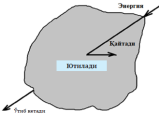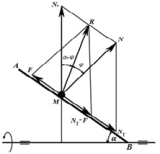JOURNAL OF “IRRIGATION AND MELIORATION”
 Innovative development is based on human resources
Innovative development is based on human resources
The republic's and the neighboring territories' arid and semi-arid climates, where artificial irrigation is the primary method of agricultural production, and the methodical implementation of reclamation measures necessitate the training of qualified specialists with up-to-date scientific knowledge and technological techniques for restoring and sustaining the productivity of irrigated soils under water-limited conditions.
28.10.2023 956
 BUILDING A 3D MODEL OF HYDRAULIC STRUCTURES USING BIM TECHNOLOGY
BUILDING A 3D MODEL OF HYDRAULIC STRUCTURES USING BIM TECHNOLOGY
J.A.Kasimov is an independent researcher, D. Kalandarova–masret student,
National Research University “Tashkent Institute of Irrigation and Agricultural Mechanization Engineers”
Abstract
In the article, the role of graphic programs in the engineering sciences in the educational system, especially in technical higher education institutions, through them, we can see that the issues related to Build Art technologies, which are the demand of today, can be easily and conveniently solved. The ability to analyze the spatial properties and tasks of subjects is an important component of the graphic preparation of students. In the field of graphic education, development of students' spatial imagination, imaginative analysis of spatial images, activation of mental and cognitive activities of students, development of spatial thinking and imagination, imaginative observation and acceptance of spatial phenomena, shapes, and acquisition of all graphic knowledge and skills, keeping in memory creative qualities such as staying have been adding a significant share to the creation of content.
Key words: BIM (Building Information Modeling), Graphical programs, education, analysis and results, hydrotechnical structures, 3D model, engineering computer graphics
16.06.2023 2268
 DETERMINATION OF ENERGY SAVING WHILE PROVIDING A STABLE OPERATION MODE BY MATHEMATICAL MODELING OF STATIC AND DYNAMIC MODES OF ASYNCHRONOUS MOTOR OF EQUIPMENT FOR GRINDING FORAGE
DETERMINATION OF ENERGY SAVING WHILE PROVIDING A STABLE OPERATION MODE BY MATHEMATICAL MODELING OF STATIC AND DYNAMIC MODES OF ASYNCHRONOUS MOTOR OF EQUIPMENT FOR GRINDING FORAGE
N.B.Pirmatov – Doctor of Technical Sciences, Professor of the Tashkent State Technical University named after I. Karimov,
A.T.Panoev – PhD., Associate Professor of the Bukhara Institute of Natural Resource Management national research university "Tashkent Institute of Irrigation and Agricultural Mechanization Engineers"
Abstract
The article presents energy efficiency by controlling the rotational speed of the asynchronous electric motor of feed grinding devices. With the help of frequency converters, you can directly control the speed by changing the frequency of the electric motor. One of the advantages of this method is that since there is a close relationship between current and torque, the frequency converter can reduce the starting current when starting the motor. When starting the engine, the engine starts smoothly and saves electricity during starting. The power factor of the universal feed grinder was calculated and analyzed by mathematical modeling using the Hurwitz criterion at 100. At the same time, in the electric drive system - the universal feeding grinder, the gain factor - 3.95 < Ку < 895 is provided for operation in a stable mode. The asynchronous motor of the universal feed chopper is optimally controlled in static and dynamic modes. Thanks to frequency control, electricity consumption can be reduced by up to 20%, and 25,920 kWt*h of electricity can be saved per year.
Key words: energy saving, electric drive, frequency converter, optimal control, operating mechanisms, energy efficiency, efficiency.
16.06.2023 1974
 THEORETICAL SUBSTANTIATION OF THE EFFECT OF TREATMENT WITH ALTERNATING ELECTRIC CURRENT ON THE VIABILITY OF GRAPEVINE CUTTINGS
THEORETICAL SUBSTANTIATION OF THE EFFECT OF TREATMENT WITH ALTERNATING ELECTRIC CURRENT ON THE VIABILITY OF GRAPEVINE CUTTINGS
N.M.Markaev – PhD, Senior Lecturer,
NRU “Tashkent Institute of Irrigation and Agricultural Mechanization Engineers”
Abstract
The article studies the energy properties of energy input into cuttings during electrical processing of a grape stem, taking into account the state of the system in two media (water and cuttings). It has been established that the energy absorbed by grape stems depends on the electrical conductivity of the cuttings (γ1), the volume concentration of the cuttings (X1), the conductivity of the electrically conductive liquid (γ2) and the volumetric concentration of the electrically conductive liquid (X2). As a result, it was determined that the two-environment system, i.e. the ratio between the volume concentration of grape cuttings (X1) and the volume concentration of the electrically conductive liquid (X2) is (X1 + X2 = 1), the diameter of the cuttings is in the range of 1.2-1.5 cm, the value of the cross-sectional surface (S) varies within 113.04-76.625 mm2, the electrical resistivity of the handle varies within 106.73-164.85 Ohm-m, also with the exposure time (τ) of the electric current, it is necessary to take into account the distance between electrodes placed in the working chamber (l), processing voltage (U).
Key words: electrodes, grape cuttings, electric current, electromagnetic field, conductivity, electrical resistivity, volumetric concentration.
16.06.2023 1974
 JUSTIFICATION OF THE PARAMETERS OF THE WORKING BODY OF THE DEVICE FOR LOCAL APPLICATION OF MANURE DURING THE FORMATION OF RIDGES
JUSTIFICATION OF THE PARAMETERS OF THE WORKING BODY OF THE DEVICE FOR LOCAL APPLICATION OF MANURE DURING THE FORMATION OF RIDGES
B.M.Khudayarov – D.S.C., professor, U.T.Kuziev – PhD associate professor, National research university “Tashkent institute of irrigation and agricultural mechanization engineers” ,
U.I.Abdumalikov – doctoral student Andijan institute of agricultural and agrotechnology
Abstract
The article presents the results of research on the substantiation of the parameters of the working body, provides information on the design of the device and its technological process of local application of semi-ripened manure of the newly formed comb on the basis of the machine for the formation of ridges.
The parameters of the blade auger feeding manure in the prescribed norm from the hopper are determined, including the rate of departure of manure particles from the blades and its pitch, the angle of installation of the blades to the shaft, the shape and dimensions of the blades.
According to the results of the research, the shape of the blade was determined, which has the form of a circle sector with a radius of 0.15 m, its area is 0.00595 m2, the angle of the blade to the shaft is 45 degrees, the width of the blade is equal to its pitch and is equal to 87 mm.With these parameters, all the requirements set for the blade auger are met.
Key words: manure, bunker, paddle auger, fence, hole, guide troughs.
16.06.2023 1645



